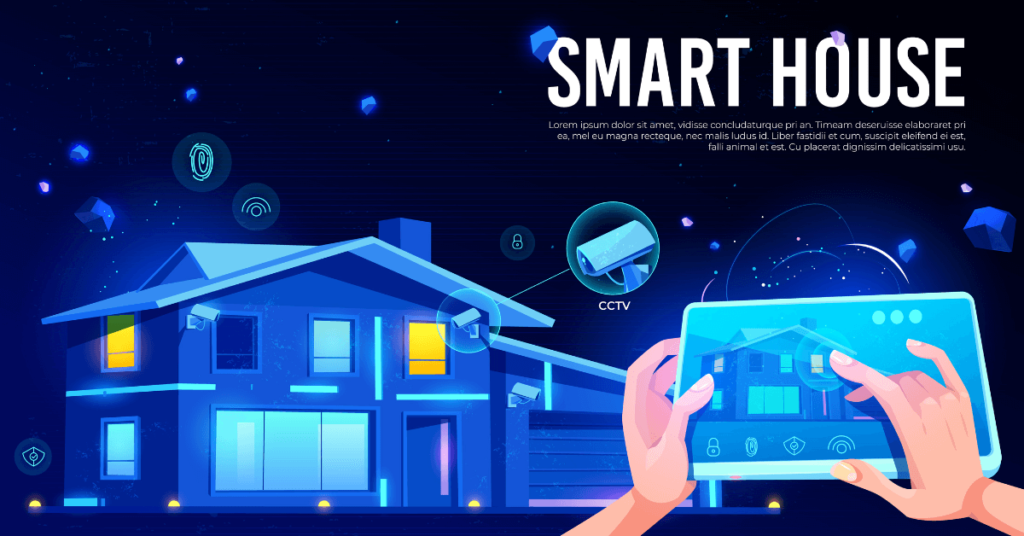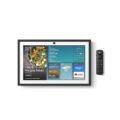Home automation works through interconnected devices controlled by a centralized system, typically via a smartphone app or voice commands. These systems coordinate appliances and gadgets to improve convenience, energy efficiency, and security.
Also Read
Home automation transforms ordinary homes into smart homes. It enhances everyday living through cutting-edge technology. It allows homeowners to manage their household devices. These include lighting, heating, and cooling systems.
They also include security cameras and entertainment systems. They can do this with a touch, a voice command, or preset rules.
This smart ecosystem gives users increased control, comfort, and peace of mind. They can enjoy knowing their home can respond to their needs and even anticipate them sometimes. It employs wireless communication protocols like Wi-Fi, Bluetooth, ZigBee, or Z-Wave.
This ensures that the various devices and control hubs effectively talk to each other. It creates a network of automated responses and actions that simplify tasks. By making houses more responsive, home automation caters to the desire for convenience. It also contributes to energy savings by optimizing resource use.
The Allure of Home Automation
Imagine stepping into a home that responds to your every need. Lights adjust to your mood. Your favorite music starts playing as you walk in. Temperature settings change to match the weather. This is not a scene from a science-fiction movie.
It’s the reality of home automation. Discover how this smart technology transforms ordinary homes into realms of high-tech luxury.
From Manual To Autonomous: The Shift In Home Management
Home management is now a hands-off experience. Here’s what has changed:
- Gone are the days of flipping switches and adjusting thermostats.
- With a single command, homes now self-adjust.
- Smart devices connect to each other, creating a seamless network.
- This network handles tasks without human touch.
- Alarms, lights, and locks operate with simplicity.
- User-friendly apps allow easy control over the entire system.
The Convenience Quotient: Why Homeowners Are Switching
So, why the switch to smart homes? Homeowners love the ease and comfort. A few reasons include:
- Saving time on daily tasks.
- Reducing energy bills through efficient use.
- Boosting home security with automated systems.
- Remote management, even when away.
- Enhancing lifestyles with personalized settings.
- Giving peace of mind, knowing that your home is smartly managed.
| Feature | Benefit |
|---|---|
| Smart Thermostats | Track and optimize your heating and cooling. |
| Automated Lighting | Save energy and improve security. |
| Intelligent Security | Monitor your home anywhere, any time. |
Core Technologies Behind Home Automation
The magic of home automation lies in various cutting-edge technologies. These technologies allow devices to communicate. They automate tasks and create a seamless living experience. Understanding the core technologies gives insights into how smart homes operate.
Let’s dive into the wireless protocols and sensor systems. They form the backbone of modern home automation.
Wireless Wonders: The Role of Wi-Fi, Bluetooth, and Zigbee
Wireless Wonders: The Role of Wi-fi, Bluetooth, And Zigbee
Wireless connectivity is essential in home automation. Wi-Fi, Bluetooth, and Zigbee are key players in this domain. They connect devices without cables for a clutter-free environment. Each technology serves unique functions within a smart home.
- Wi-Fi: Ubiquitous and able to transfer large amounts of data. Ideal for high-bandwidth devices like smart TVs.
- Bluetooth: Connects devices over short distances. Perfect for gadgets like smartwatches and headphones.
- Zigbee: Excels in creating low-power mesh networks. Smart lights and sensors often use Zigbee.
Sensors and Responders: The Nervous System of Smart Homes
Sensors And Responders: The Nervous System of Smart Homes
Sensors and responders make smart homes truly intelligent. They detect changes and initiate appropriate actions. This is much like a nervous system in the human body.
| Type of Sensor | Function | Common Applications |
|---|---|---|
| Motion Sensors | Detect movement | Security cameras, lights |
| Contact Sensors | Monitor open/close status | Doors, windows |
| Temperature Sensors | Measure heat levels | Thermostats, fridges |
Responders receive signals from sensors and activate devices accordingly. For example, a smart thermostat adjusts the temperature when a room gets warmer or colder.
Smart Hubs And Controllers: The Brains of The Operation

Picture your home as a symphony. Your smart devices are like instruments. Just like a conductor, smart hubs and controllers lead your smart home orchestra. They turn separate devices into a harmonious system. This system listens and reacts to your every command.
Centralizing Control: How Smart Hubs Integrate Devices
Smart hubs are like secret agents. They connect different gadgets across various protocols. They use Wi-Fi, Z-Wave, and Zigbee. This lets devices talk to each other. They can work as one team. Think of it as making friends in a playground. Once connected, they play together seamlessly.
- Connectivity: Hubs use common languages to link devices.
- Compatibility: They work with many brands and types.
- Automation: Set rules, and they manage your home for you.
Voice Control And Mobile Apps: Interfacing With Your Smart Home
Interact with your home like never before. Speak out your wishes, and your home obeys. It’s as easy as asking your friend to pass the ketchup. Your words or smartphone gestures take control.
- Use voice assistants like Alexa or Siri.
- Tap your phone and make magic happen.
- Customize scenes for bedtime or movie nights.

Credit: appsaware.com
Common Home Automation Features And Their Functions
Welcome to the world of convenience with home automation. Each feature plays a special role in creating a smart, connected home. Let’s explore some popular ones and their amazing capabilities.
Automated Climate Control: Optimizing Comfort And Efficiency
Automated climate control transforms house temperatures with ease and precision. With this feature, residents enjoy tailor-made comfort. Let’s dive into its functions:
- Smart thermostats adjust temperatures based on daily routines.
- Sensors detect room occupancy to save energy in empty spaces.
- Remote adjustments allow temperature control from anywhere, anytime.
- Integration with weather forecasts prepares your home for climate changes.
Overall, this system means less effort and more saving on energy bills.
Security And Surveillance: Keeping A Digital Watch
Security is a top priority in smart homes. Here are key functions of home automation security and surveillance:
| Feature | Function |
|---|---|
| Smart Locks | Lock or unlock doors with smartphones or voice commands. |
| Surveillance Cameras | Monitor home interiors and exteriors in real-time. |
| Motion Detectors | Trigger alerts when unexpected movement is detected. |
| Window and Door Sensors | Alert homeowners if windows or doors are opened. |
These features work together for a safe, secure living environment. They offer peace of mind, knowing the house is under constant watch.
Setting Up Your Smart Home
Welcome to the future of living, where setting up your Smart Home is like unwrapping a gift that keeps on giving. With a smart home, you can control appliances, lights, and even your thermostat from anywhere in the world. Let’s dive into making your home smart and intuitive!
The Installation Process: Diy Vs. Professional Setups
Embrace the power of choice in how you install your smart home gadgets. You can DIY (Do It Yourself) or opt for a professional to take the reins. Each path has its perks.
| DIY Installation | Professional Installation |
|---|---|
|
|
For the DIY enthusiast, it’s a thrilling project filled with learning opportunities. Installing smart plugs, cameras, or a thermostat? Follow the manual. Run into a hurdle? Online communities and videos are your friends. Go at your own pace and enjoy the journey.
The professional route offers ease. Hiring an experienced installer can save time and ensure your system works flawlessly. Get guidance on the best devices and let them handle the complex wiring and setup.
Compatibility And Integration: Making Sure Your Devices Communicate
Think of your smart home devices as team members; it’s crucial they all speak the same language. Compatibility ensures your devices work together seamlessly.
- Identify the protocol: Zigbee, Z-Wave, Wi-Fi, or Bluetooth.
- Check compatibility: Ensure new devices can communicate with your existing system.
- Use a central hub: It’s the quarterback of your smart home, letting all devices connect and communicate.
- Choose a unified app: Manage all devices from one platform to avoid the hassle of multiple apps.
Equipping your home with compatible devices creates a robust network. This network thrives on integration, where devices combine forces to automate your home efficiently. Pick the right ecosystem, and you’ll enjoy a cohesive experience.

Credit: martechseries.com
The Future of Home Automation
Home automation is evolving at a breathtaking pace. It has moved from simple remote control to advanced systems that learn your habits. The journey does not stop here. The tech advancements paint a future where smart homes are not just connected, but also intuitive, and incredibly responsive to our needs. The next wave of innovation will further transform the way we interact with the spaces we live in.
Innovations on The Horizon: What’s Next For Smart Homes?
- Voice-controlled Smart Rooms
- AI that Predicts Behavior Patterns
- Seamless Integration with Wearable Tech
- Energy-saving Smart Grids
- Robotic Personal Assistants
Privacy And Security Considerations In An Automated Age
Smart homes bring convenience but also raise privacy and security questions. With more devices comes greater risk of data breaches and privacy invasions. Manufacturers and users must prioritize robust security protocols and adhere to strict privacy standards to protect sensitive information. Constant vigilance and innovation in cybersecurity will be critical to ensuring that our homes remain safe as well as smart.
| Concern | Response |
|---|---|
| Data Breaches | Implement Advanced Encryption |
| Hacking Attempts | Adopt Two-Factor Authentication |
| Privacy Erosion | Ensure User Anonymity Options |
| Surveillance Worries | Transparent Use Terms |

Credit: www.facebook.com
Frequently Asked Questions for How Does Home Automation Work?
What Is Home Automation Technology?
Home automation technology involves controlling household features remotely or automatically. It integrates devices connected through the internet. This enables control over lighting, climate, entertainment systems, and appliances. It enhances convenience and energy efficiency.
How Do Home Automation Systems communicate?
Home automation systems communicate using wireless protocols like Wi-Fi, Zigbee, or Z-Wave. These protocols allow devices to connect and interact with a central hub. They also allow them to connect and interact with a smartphone or tablet. This lets users control them from anywhere with internet access.
Can Home Automation Save Energy?
Yes, home automation can save energy. Smart thermostats adjust your home’s temperature for optimal efficiency. You can program automated lighting and appliances to turn off when not in use. This reduces unnecessary power consumption.
What Devices Are Common In Home Automation?
Common home automation devices include smart thermostats, smart locks, connected lighting systems, home security cameras, and smart speakers. These devices provide convenience, security, and energy savings. They allow remote and automated control.
Conclusion
Home automation blends convenience and efficiency into everyday living. Control lights, climate, and security with a tap. Embrace the future; enhance your home with smart technology today. Are you ready to simplify your life? Start your journey into home automation now.



